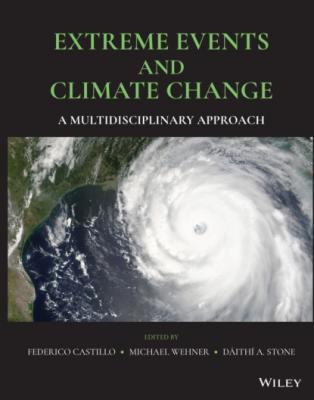Extreme Events and Climate Change. Группа авторов
Читать онлайн.| Название | Extreme Events and Climate Change |
|---|---|
| Автор произведения | Группа авторов |
| Жанр | География |
| Серия | |
| Издательство | География |
| Год выпуска | 0 |
| isbn | 9781119413646 |
22 Stone, D., Auffhammer, M., Carey, M., Hansen, G., Huggel, C., Cramer, W., Lobell, D., Molau, U., Solow, A., Tibig, L., & Yohe, G. (2013). The challenge to detect and attribute effects of climate change on human and natural systems. Climate Change, 121, 381–395.
23 United Nations. (1992). United Nations Framework Convention on Climate Change. FCCC/INFORMAL/84, https://unfccc.int/resource/docs/convkp/conveng.pdf
24 United Nations. (2015). Adoption of the Paris Agreement. FCC‐C/CP/2015/L.9/Rev.1. https://undocs.org/en/FCCC/CP/2015/L.9/Rev.1
2 The Impact of Heat Waves on Agricultural Labor Productivity and Output
Federico Castillo1, Armando Sánchez Vargas2, J. K. Gilless1, and Michael Wehner3
1Federico Castillo and J. K. Gilless work at the University of California, Berkeley, Department of Environmental Science, Policy, and Management, Berkeley, California
2Armando Sánchez Vargas works at the Institute of Economic Research of the National Autonomous University of Mexico (UNAM), Mexico City, Mexico.
3Michael Wehner works at the Lawrence Berkeley National Laboratory, Berkeley, California.
ABSTRACT
This chapter analyzes the impact of heat waves on the productivity of selected crops in California’s agricultural sector. We use a panel data ensemble to estimate the impact of heat waves on agricultural labor and the subsequent impact on crop productivity. Data used include crop prices, acreage harvested, crop labor requirements, production costs, capital, and the heat index. The counties included in the study are Fresno, Yolo, Kern, San Joaquin, and Imperial. Our results indicate that the impact of heat waves on a relatively labor‐intensive crop such as watermelons can be significant because an increase in the number of days that exceed the range of 95OF to 100OF to over 100OF results in productivity decreases on the range of 4% to 6%. For onions our results indicate that the decline in productivity is less but significant in terms of dollar amounts. Our research is an improvement on previous studies that have analyzed the impact of temperature on agricultural production in that our framework isolates the impact of heat on labor first and then incorporates it into a production function instead of using temperature as a regression variable directly, which could result in spurious outcomes. Our method complements other studies that have analyzed the impact of extreme temperatures on crop productivity and using an agronomic modeling approach.
2.1. CALIFORNIA AGRICULTURE
The agricultural sector of California is an important component of the overall US agricultural sector.
2.1.1. Production
California’s cash crops receipts of US $50.1 billion in 2017 were the highest for any state, almost double Iowa’s. California is also the top agricultural exporter, with total cash value exports of US $20.5 billion in 2017. Moreover, California is the major or sole state exporting many agricultural commodities, such as almonds, dates, garlic, olives, and olive oil, among others. Table 2.1 shows the top 10 commodities produced in California for the year 2017, a diversified portfolio of both permanent and seasonal crops. There has been little change in the state’s top 10 crops in recent years except for broilers and pistachios, which replaced walnuts and oranges, respectively.
Agricultural production in California depends heavily on water delivery systems that transport water from the Sierra Nevada Mountains to Northern and Central Valley regions and the Colorado River to the Southern California region. Production takes place in a wide variety of geographical areas from the border with Mexico to the northern counties of Napa, Yolo, and Sonoma. Table 2.2 shows the 10 leading agricultural counties ranked by total crop value produced and the leading commodities for each county in 2017.
Table 2.1 Top Ten Agricultural Commodities in California in 2017 and 2015 Ranking.
Source: California Department of Food and Agriculture (2018).
| Commodity (2017 ranking) | Value (US $1,000) (in decreasing order) | 2015 Ranking |
|---|---|---|
| Milk and cream | 6,651,720 | 1 |
| Grapes | 5,793,217 | 3 |
| Almonds (shelled) | 5,603,590 | 2 |
| Berries, all strawberries | 3,100,215 | 6 |
| Cattle and calves | 2,625,413 | 4 |
| Lettuce, all | 2,414,669 | 5 |
| Walnuts | 1,593,900 | 9 |
| Tomatoes, all | 1,054,001 | 7 |
| Pistachios | 1,014,507 | 13 |
| Broilers | 939,409 | 12 |
Table 2.2 Top 10 Leading Producing Counties in California and Leading Crops/Activities for Each County (2018).
Source: California Department of Food and Agriculture (2018).
| County | Total Value (US $1,000) | Leading Crops |
|---|---|---|
| Kern | 7,254,004 | Grapes, almonds, pistachios, milk |
| Fresno | 6,369,926 | Milk, grapes, cattle and calves, oranges |
| Monterrey | 4,425,425 | Strawberries, lettuce, broccoli, grapes |
| Stanislaus | 3,183,150 | Almonds, milk, chickens, nursery |
| Merced | 3,409,518 | Almonds, milk, cattle and calves, chickens |
| San Joaquin | 2,527,966 |
Grapes, almonds, walnuts, milk
|
